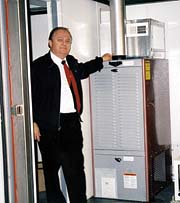
The lucky travelers in this story are 10 "highboy" Thermo Pride oil furnaces.
The Thermo Pride oil furnaces have been selected to heat 10 mobile drilling structures as part of the National Science Foundation's IceCube project. IceCube is a high-energy neutrino telescope, which scientists hope will be capable of detecting subatomic particles that might reveal new information about the most distant and violent events in the universe.
"The intention of the equipment is to maintain temperature within these instrumented structures," said Everett James, Thermo Pride director of engineering. "These are not the living quarters. This is where the pumps, water heaters, high-pressure water heaters, and other instrumentation are stored."
IceCube
The University of Wisconsin (Madison) has received $15 million in federal funding for the first phase of this multiyear project. The university leads the international collaboration of 23 institutions that are working on this project.To build the telescope, scientists must first drill as many as 80 2.5-kilometer-deep holes in the polar ice to deploy strings of photomultiplier tubes that will transform the Antarctic ice into an enormous detector that will be the heart of the telescope. Working at the bottom of the world in temperatures of 50 degrees below zero, drillers will use a jet of hot water to melt a hole into the ice to deploy a string of 60 optical modules on a long electrical cable. Like beads on a string, these modules will be connected to a single processing facility on the surface, creating a telescope out of over a cubic kilometer of Antarctic ice.
Thermo Pride
Thermo Pride oil furnaces will operate to maintain drilling, pumping, and test equipment at acceptable levels to perform in the harsh condition of the Antarctic where "summer" conditions reach between -30 degrees and -50 degrees F. A modified JP-8 jet fuel will be utilized as the energy source on customized Beckett oil burners. Thermo Pride furnace components have been modified to withstand the rugged low start-up temperatures, but that's only half the battle.The furnaces have to withstand the rigors of the shipping process, which included over-the-road transportation from Wisconsin to California, sea travel to the South Pole, and air transport to a base camp on the ice.
James said the first furnaces were mounted in shipping containers by his engineering crew at the University of Wisconsin, tested, and then shipped to the South Pole. The equipment has been arriving at the site for testing, which is scheduled to begin in January 2004.
The project has gone off with only one minor hitch.
"We had to install flue vents, which were to extend beyond the cabinet structures," James said. "But for shipping purposes, nothing can extend beyond the size of the container. We had to design vent systems which are permanently installed inside the cabinet and include removable caps," which are installed after shipping.
"They will be shut down after the three-month drilling season, and the equipment will be stored in an offsite location, where they will sit until the next season, where they will be dragged across the ice and hooked back up for drilling," James commented. "The temperatures during the storage season can get as low as 100 degrees below zero."
For more information about Thermo Pride, call 800-348-5130 or visit www.thermopride.com.
Publication date: 12/15/2003

Report Abusive Comment